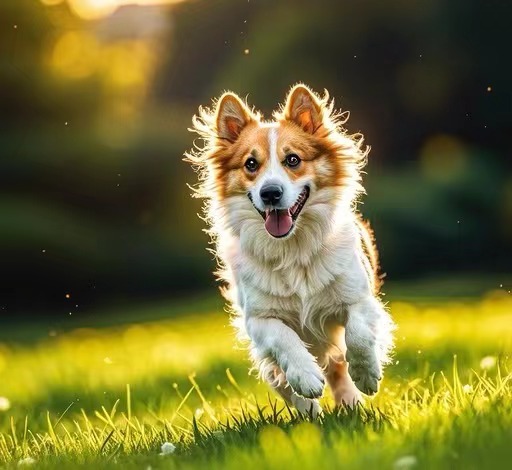
by TCMVET | Feb 21, 2024 | pet Chinese herbal medicine
In the realm of veterinary health, canine thyroid cancer remains a challenging adversary. As pet owners increasingly seek holistic and natural treatment options, the ancient practice of using herbs has gained traction. This article delves into how traditional herbal remedies offer a beacon of hope in the fight against thyroid cancer in dogs, blending age-old wisdom with modern veterinary care.
Understanding Canine Thyroid Cancer: Thyroid cancer in dogs typically develops along the thyroid gland trenches, often without initially affecting the gland’s hormone production. However, it can metastasize, spreading to other parts of the body. Symptoms may include weight loss, increased heart rate, hypertension, and heightened energy levels. While the exact causes remain unclear, genetic factors and immune system anomalies are suspected contributors. Breeds like Golden Retrievers, Cocker Spaniels, and Irish Setters are particularly susceptible.
The Role of Herbal Remedies: Herbal remedies, a cornerstone of traditional medicine for millennia, are now being revisited for canine health. These natural treatments are believed to work by enhancing the body’s ability to fight cancer and support overall well-being.
Key Herbs in Focus:
- Turmeric (Curcuma longa): Known for its anti-inflammatory properties, turmeric contains curcumin, a compound that has been studied for its anti-cancer effects.
- Milk Thistle (Silybum marianum): Often used for liver support, milk thistle may also help in detoxifying the body from cancer treatment side effects.
- Astragalus (Astragalus membranaceus): This herb is reputed to boost the immune system, potentially aiding in the body’s fight against cancer cells.
- Ginseng (Panax ginseng): Ginseng is praised for its overall health benefits, including immune support and vitality enhancement, which can be crucial for cancer-afflicted dogs.
Integrating Herbs with Conventional Treatments: While herbs offer promise, they should not replace conventional treatments like surgery or radiation. Instead, they can be used in conjunction with these methods. It’s essential to consult with a veterinarian before starting any herbal regimen, as some herbs can interact with conventional medications.
The Importance of a Holistic Approach: A holistic approach, focusing on diet, exercise, and mental well-being, alongside herbal and conventional treatments, provides a comprehensive strategy for managing thyroid cancer in dogs. Nutrition, in particular, plays a crucial role, and a diet rich in antioxidants and omega-3 fatty acids can support overall health and resilience.
The fusion of ancient herbal wisdom and modern veterinary science offers a new horizon in treating canine thyroid cancer. While further research is needed to fully understand and optimize these natural remedies, the initial results are promising. By adopting a holistic approach, we can provide our canine companions with a fighting chance against thyroid cancer, ensuring their health and happiness for as long as possible.

by TCMVET | Feb 20, 2024 | Dog Cancer & Tumors
Bone cancer in middle-aged dogs, particularly osteosarcoma, is a significant health concern that affects countless canines and their owners worldwide. In the quest for more effective treatments, Traditional Chinese Medicine (TCM) is emerging as a beacon of hope. This article explores how the ancient practices of TCM are providing new pathways for treating bone cancer in middle-aged dogs.
Understanding Canine Bone Cancer
Bone cancer, most commonly osteosarcoma, is a severe and often aggressive disease, predominantly affecting larger breeds of middle-aged dogs. It is characterized by rapid tumor growth, primarily in the limbs, and can be challenging to treat with conventional methods alone.
The Potential of TCM in Canine Oncology
TCM offers a holistic approach to health and disease, focusing on balancing the body’s energies and enhancing its natural healing capabilities. This philosophy is increasingly being applied to veterinary oncology, with promising results in the treatment of canine bone cancer.
Key Elements of TCM in Cancer Treatment
- Herbal Medicine: TCM utilizes a variety of herbs known for their healing properties. Herbs like Huang Qi (Astragalus) and Yun Zhi (Turkey Tail mushroom) are used for their potential to boost the immune system and combat tumor growth.
- Acupuncture: Often used for pain relief, acupuncture can also enhance the overall well-being of dogs with cancer, potentially alleviating symptoms and improving quality of life.
- Diet and Nutrition: TCM emphasizes the importance of a balanced diet tailored to the dog’s specific needs, which can support their overall health and resilience during cancer treatment.
Integrating TCM with Conventional Cancer Treatments
The most effective approach in treating canine bone cancer often involves a combination of TCM and conventional treatments like surgery, chemotherapy, and radiation. This integrative approach aims to maximize the effectiveness of treatment, reduce side effects, and improve the dog’s quality of life.
Research and Case Studies on TCM in Canine Bone Cancer
Emerging studies and anecdotal evidence suggest that TCM can play a valuable role in treating bone cancer in dogs. Case studies have shown improved outcomes, including longer survival times and better quality of life when TCM is integrated with conventional treatments.
The Future of Canine Cancer Treatment
The use of TCM in treating canine bone cancer represents an exciting development in veterinary medicine. It offers a more comprehensive approach to treatment, focusing not only on fighting the cancer but also on supporting the overall health and well-being of the dog.
Harnessing the power of TCM provides new hope for middle-aged dogs battling bone cancer. As veterinary medicine continues to evolve, the integration of ancient wisdom and modern science paves the way for more effective and compassionate cancer treatments.

by TCMVET | Feb 20, 2024 | Dog Cancer & Tumors
Appendicular osteosarcoma, a prevalent form of bone cancer in dogs, particularly affects limbs and poses a significant challenge in veterinary oncology. Recently, innovative approaches have emerged, highlighting the use of Traditional Chinese Medicine (TCM), especially Chinese herbs, as a complementary treatment. This article explores the potential of these herbs in revolutionizing the treatment of appendicular osteosarcoma in canines.
Understanding Appendicular Osteosarcoma in Canines
Appendicular osteosarcoma is characterized by the aggressive growth of tumors in the limb bones of dogs. It is most common in larger breeds and tends to be diagnosed in middle to older age. Traditional treatments include surgery, chemotherapy, and radiation, which can be effective but often come with severe side effects.
The Emergence of TCM in Veterinary Oncology
TCM has been used for thousands of years to treat various ailments in humans and is now gaining recognition in veterinary medicine. Its holistic approach, focusing on restoring balance and enhancing the body’s natural healing capabilities, is particularly appealing for chronic conditions like cancer.
Chinese Herbs and Their Anti-Cancer Properties
Several Chinese herbs are known for their potential anti-cancer properties:
- Huang Qi (Astragalus): Boosts the immune system and may inhibit tumor growth.
- Yun Zhi (Turkey Tail mushroom): Contains polysaccharides which are believed to support the immune system and combat cancer cells.
- Bai Hua She She Cao (Hedyotis): Traditionally used for its anti-tumor effects.
These herbs are thought to work synergistically with conventional treatments, potentially reducing side effects and improving outcomes.
Case Studies and Clinical Evidence
Although research in this area is still developing, several case studies have reported positive outcomes when Chinese herbs are used alongside conventional cancer treatments in dogs. These studies suggest improved quality of life and extended survival times.
Integrating Chinese Herbs into Conventional Treatment Plans
Integrating Chinese herbs into a canine’s cancer treatment plan should be done under the guidance of a veterinarian skilled in both conventional and TCM practices. This ensures a safe and effective combination of treatments tailored to the individual dog’s needs.
The Future of Canine Cancer Treatment
As research continues, the integration of Chinese herbs into the treatment of appendicular osteosarcoma in canines represents a promising frontier. This approach not only offers a more holistic treatment option but also paves the way for more personalized and less invasive cancer therapies.
The innovative use of Chinese herbs in treating appendicular osteosarcoma in canines is a testament to the evolving nature of veterinary medicine. By embracing the wisdom of TCM and integrating it with modern science, we can offer our canine companions more effective and compassionate care.

by TCMVET | Feb 20, 2024 | Dog Cancer & Tumors
In the realm of veterinary medicine, the treatment of canine osteosarcoma, especially in large breeds, has been a persistent challenge. Bridging the gap between age-old practices and contemporary science, Traditional Chinese Medicine (TCM) offers a complementary approach to conventional methods. This article delves into how TCM is being employed to confront osteosarcoma in large breed dogs, blending traditions for better outcomes.
Understanding Canine Osteosarcoma
Osteosarcoma is a type of bone cancer predominantly seen in large and giant breed dogs. It is characterized by the aggressive growth of tumors, primarily in the limbs. The conventional treatment protocol often involves surgery, chemotherapy, or radiation, which can be intensive and taxing for the animal.
The TCM Perspective on Canine Osteosarcoma
TCM focuses on restoring balance and enhancing the body’s natural healing abilities. In the context of canine osteosarcoma, TCM aims to strengthen the dog’s overall constitution, support immune function, and manage symptoms, thus complementing conventional cancer treatments.
Key Chinese Herbs in Osteosarcoma Treatment
Several herbs are prominent in TCM for their purported anti-cancer properties:
- Huang Qi (Astragalus): Known for boosting the immune system and potentially inhibiting tumor growth.
- Yun Zhi (Turkey Tail mushroom): Contains polysaccharides that are believed to enhance immune responses.
- Bai Hua She She Cao (Hedyotis): Traditionally used for its anti-tumor effects.
These herbs are often administered in conjunction with conventional treatments to optimize the dog’s response to therapy.
Integrating TCM with Conventional Veterinary Practices
The integration of TCM in treating osteosarcoma involves a holistic strategy. While not a replacement for surgery or chemotherapy, TCM can be an adjunct, potentially reducing side effects, enhancing the effectiveness of conventional treatments, and improving the quality of life for the canine patient.
The Role of Diet and Lifestyle in TCM
TCM also emphasizes the importance of diet and lifestyle in maintaining health and fighting disease. A diet tailored to support a dog with osteosarcoma, coupled with a stress-free environment, can significantly contribute to the overall treatment plan.
Research and Case Studies on TCM in Canine Osteosarcoma
Emerging research and case studies provide insights into the effectiveness of TCM in treating canine osteosarcoma. These studies often highlight improved outcomes, better tolerance to conventional treatments, and enhanced quality of life.
By bridging traditions and using TCM in conjunction with modern veterinary science, we can offer a more rounded and potentially effective approach to treating osteosarcoma in large breed dogs. As research continues to unfold, this integrative approach might well become a mainstay in veterinary oncology, providing hope and improved care for our canine companions.

by TCMVET | Feb 20, 2024 | Dog Cancer & Tumors
In the ongoing quest to find effective treatments for canine bone cancer, particularly osteosarcoma, the wisdom of ancient remedies is gaining attention. This article explores the role of Traditional Chinese Medicine (TCM), specifically Chinese herbs, in addressing the modern challenge of bone cancer in dogs.
The Prevalence of Canine Bone Cancer
Osteosarcoma, the most common form of bone cancer in dogs, predominantly affects larger breeds and tends to occur in middle-aged dogs. The aggressive nature of this cancer and its tendency to metastasize make it a formidable opponent in veterinary oncology.
Traditional Chinese Medicine: A Holistic Approach
TCM, a medical practice with thousands of years of history, is renowned for its holistic approach to health and disease. It operates on the belief that treating the whole body and restoring balance is key to healing. In the context of canine osteosarcoma, this philosophy offers a unique perspective in treatment.
Chinese Herbs in the Fight Against Cancer
Several herbs used in TCM are known for their anti-cancer properties. For example:
- Huang Qi (Astragalus): Boosts the immune system and has anti-tumor properties.
- Yun Zhi (Turkey Tail mushroom): Contains polysaccharides that support immune function.
- Bai Hua She She Cao (Hedyotis): Renowned for its anti-tumor effects.
These herbs are believed to help control the spread of cancer and alleviate symptoms, enhancing the overall quality of life for affected dogs.
Integrating Chinese Herbs with Conventional Treatments
The most effective approach in treating canine bone cancer involves combining TCM with conventional methods like surgery, chemotherapy, and radiation. This integrative approach aims to maximize the efficacy of treatment, minimize side effects, and improve the overall well-being of the dog.
The Science Behind the Remedies
While traditional use and anecdotal evidence support the effectiveness of these herbs, scientific research is essential to validate their efficacy. Emerging studies have started to explore the potential benefits of integrating Chinese herbal medicine with conventional cancer treatments.
Diet and Lifestyle Changes
TCM also emphasizes the importance of diet and lifestyle in treating diseases. A balanced diet, enriched with specific nutrients and herbal supplements, along with a healthy lifestyle, can play a crucial role in supporting dogs with cancer.
Exploring ancient remedies like Chinese herbs in the fight against canine bone cancer represents a promising avenue in veterinary medicine. By integrating these time-honored treatments with modern veterinary practices, we can offer a more comprehensive and compassionate approach to our canine companions’ health challenges.






